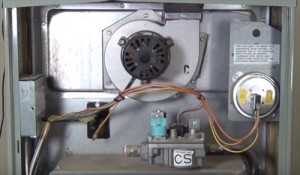
A gas furnace is made of many parts that can be broken down into their individual components.
Each component will have a specific task, or the furnace will not operate correctly.
Below are the main basic components for almost any gas furnace.
Gas Furnace Components and Parts Explained
- Heat Exchanger
- Igniter and Pilot lights
- Burners
- Gas Valve
- Thermocouple
- Flame Sensor
- Draft Inducer Motor
- Pressure Switch
- Blower Motor
- Blower Motor Capacitor
- Furnace Limit Switch
- Return Air Filter
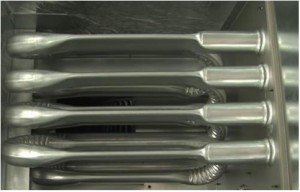
When gas burns, it gives off toxic fumes, including carbon monoxide, which is dangerous when breathed in. A heat exchanger is used to keep the toxic gases separate from the air that is blown through a home.
A heat exchanger is simply long metal tubes that are S-shaped. Gas flames burn inside the tubes, and the toxic gases vent out of the home through the roof. The blower motor forces air past the outside of the tubes, heating the air as it does. This keeps the toxic flames separate from the clean air that is blown into a home.
The heat exchanger should be examined on a regular basis because any cracks or damage to the heat exchanger can allow toxic gases into a home. Carbon monoxide detectors should always be used in a home to help and spot any problem that may occur if there is a leak in the heat exchanger.
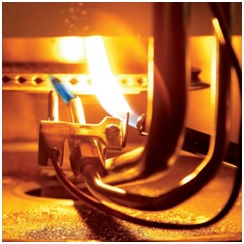
Gas furnaces need a way to light the gas to start a flame. Older furnaces use a pilot light that burns constantly, lighting the gas when it comes on. Modern furnaces use a hot surface igniter (HSI) that will glow red hot and ignite the gas.

A burner is where gas and air are combined, creating a flame that becomes the heat source.

Natural gas is piped throughout the Country into cities and into homes. As it is piped from one stage to another, it is set at different pressures.
At the point it comes into a home, the pressure is usually between 8-12 inches of Water Column. It goes through a gas valve and is stepped down the correct pressure for the furnace, usually 3-5 inches of Water Column.
Inches of Water Column is is used to measure gas pressure.
The gas valve controls the gas going into a furnace, including shutting the gas off when a safety switch fails.
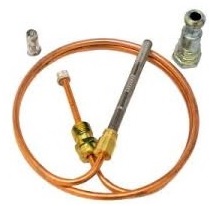
A Thermocouple is used with a pilot light to sense whether the pilot light is lit.
It uses two small metal wires inside of a tube that, when heated, conduct electricity sending a 24-Volt signal to the gas valve allowing gas to flow. If a thermocouple is bad or does not sense any heat, then it will shut the gas off.
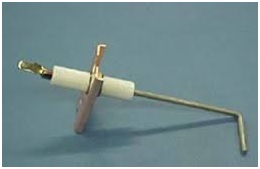
A flame sensor works as a safety to detect heat when a Hot Surface Igniter is used. If it does not detect heat, it will shut off the gas.
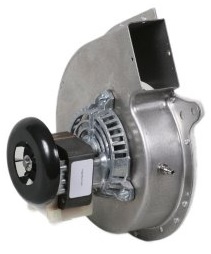
Since gas, when burned, gives off toxic fumes, it is necessary to vent the fumes from home through a vent. A draft inducer motor turns on before the gas is allowed to burn. This creates a small vacuum that pushes air out the vent pipe.
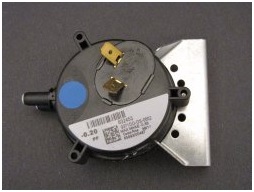
A furnace pressure switch is used to make sure the draft inducer motor has turned on and is pushing gases out the vent pipe. It does this by using a small diaphragm that pulls in when the inducer motor is on, creating a vacuum. If there is a vacuum and the diaphragm pulls in, it activates a switch which allows the gas to begin to flow. If it does not sense a vacuum, then no gas will be allowed into the system.
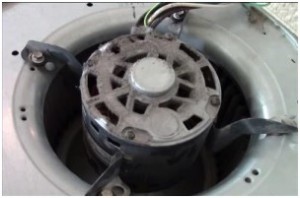
A blower motor is what is used to blow air into a home through vents.
The blower motor blows air in a home by pulling in air from a Return Air filter, past the heat exchanger, and blowing it out the vents.
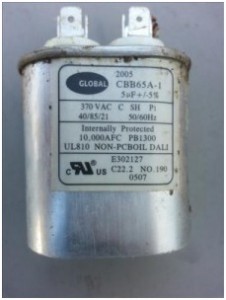
A blower motor capacitor is used to help start a blower motor and in some cases help it to run at a steady rate of speed.
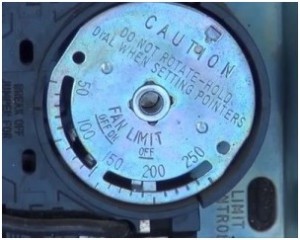
If a furnace becomes too hot, then a limit switch is used to turn off the gas as a safety. For example, if a blower motor stops working and no air circulated, temperatures will rise inside of a furnace. If this happens, a limit switch will shut off the gas to the furnace until the problem is fixed.
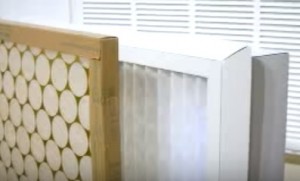
A furnace air filter is necessary to keep out dust and other debris from entering a unit. A dirty air filter will cause a furnace to not work properly and should be replaced frequently.
Does anyone have any ideas on where I can purchase a replacement Blower motor for a 2008 Keep-rite furnace.
My furnace was installed in 2009 and the HVAC service persons keep referring to it as an old Furnace .
In my humble opinion, it shouldn’t fail at such a young age. MOST manufacturers provide a 20 yr warranty on the heat exchangers so your part should be covered. Labor shouldn’t be more than $400-$500 because it doesn’t take all day to replace it! I’d fight for warranty coverage and since there are only a few other parts that would cost over $300 to replace, I’d just replace the parts. That being said, prices go up every year so if you decided to wait and replace say 2 yrs down the road it could be $500 or more additional to your quote to replace. That’s a hard decision. Since my husband is an HVAC contractor we always repair rather than replace. I hope someone close to you can help you decide because that’s a lot of money either way.
I have a red push button on a part on my furnace the furnace won’t start unless I push it. Also the wires on this part make a humming sound
Dan, the equipment is in need of service. Your question is published as an answer to another question and will not be noticed.
I have a 12-year-old Byrant Model 163A/165A furnace. My HVAC company tells me I need a new heat exchanger (corroding) and a new blower fan because the blades are starting to crack. To repair they quoted me $600.00 and to buy a new one $3,000 to $4300.00. The heat exchanger is still covered by warranty. Should I repair or replace?
Personally, I would replace it. A heat exchanger is not something to take chances on. Either way be sure you have carbon monoxide detectors and you will be alight.
Are you serious? You should take this as a life or death matter. A crack in the flame and heat chamber is serious. If your flame is not pure blue, your furnace can produce large amounts of carbon monoxide in just a few hours. If your carbon monoxide detector is not working right. Well you know what happens after that.
Tricky decision. One after another part will start failing in next three years. I replaced one after another part And practically built a new furnace. This is my experience. Decision is yours.
Hi Beth, not sure if you already did the deed and purchased a new unit. I have the same issue that my secondary heat exchanger is cracked. I found a bulletin from Carrier SMB-09-0024A that covers my unit and offers an enhanced warranty for 20 years that includes labor. This is the route that I am taking as this is the only issue that I have had with my unit (knock on wood). I totally understand the decision is yours. I just feel that a furnace should last at least 20+ years. There is also a law suit on this exact issue between different companies you should really do some research before just replacing your unit. Best to you.